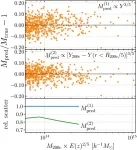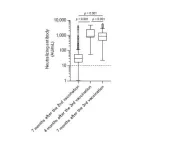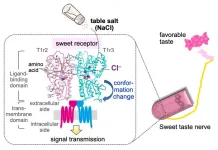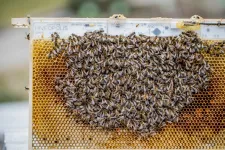(Press-News.org) Astrophysicists at the Institute for Advanced Study, the Flatiron Institute and their colleagues have leveraged artificial intelligence to uncover a better way to estimate the mass of colossal clusters of galaxies. The AI discovered that by just adding a simple term to an existing equation, scientists can produce far better mass estimates than they previously had.
The improved estimates will enable scientists to calculate the fundamental properties of the universe more accurately, the astrophysicists reported March 17, 2023, in the Proceedings of the National Academy of Sciences.
“It’s such a simple thing; that’s the beauty of this,” says study co-author Francisco Villaescusa-Navarro, a research scientist at the Flatiron Institute’s Center for Computational Astrophysics (CCA) in New York City. “Even though it’s so simple, nobody before found this term. People have been working on this for decades, and still they were not able to find this.”
The work was led by Digvijay Wadekar of the Institute for Advanced Study in Princeton, New Jersey, along with researchers from the CCA, Princeton University, Cornell University and the Center for Astrophysics | Harvard & Smithsonian.
Understanding the universe requires knowing where and how much stuff there is. Galaxy clusters are the most massive objects in the universe: A single cluster can contain anything from hundreds to thousands of galaxies, along with plasma, hot gas and dark matter. The cluster’s gravity holds these components together. Understanding such galaxy clusters is crucial to pinning down the origin and continuing evolution of the universe.
Perhaps the most crucial quantity determining the properties of a galaxy cluster is its total mass. But measuring this quantity is difficult — galaxies cannot be ‘weighed’ by placing them on a scale. The problem is further complicated because the dark matter that makes up much of a cluster’s mass is invisible. Instead, scientists deduce the mass of a cluster from other observable quantities.
In the early 1970s, Rashid Sunyaev, current distinguished visiting professor at the Institute for Advanced Study’s School of Natural Sciences, and his collaborator Yakov B. Zel’dovich developed a new way to estimate galaxy cluster masses. Their method relies on the fact that as gravity squashes matter together, the matter’s electrons push back. That electron pressure alters how the electrons interact with particles of light called photons. As photons left over from the Big Bang’s afterglow hit the squeezed material, the interaction creates new photons. The properties of those photons depend on how strongly gravity is compressing the material, which in turn depends on the galaxy cluster’s heft. By measuring the photons, astrophysicists can estimate the cluster’s mass.
However, this ‘integrated electron pressure’ is not a perfect proxy for mass, because the changes in the photon properties vary depending on the galaxy cluster. Wadekar and his colleagues thought an artificial intelligence tool called ‘symbolic regression’ might find a better approach. The tool essentially tries out different combinations of mathematical operators — such as addition and subtraction — with various variables, to see what equation best matches the data.
Wadekar and his collaborators ‘fed’ their AI program a state-of-the-art universe simulation containing many galaxy clusters. Next, their program, written by CCA research fellow Miles Cranmer, searched for and identified additional variables that might make the mass estimates more accurate.
AI is useful for identifying new parameter combinations that human analysts might overlook. For example, while it is easy for human analysts to identify two significant parameters in a dataset, AI can better parse through high volumes, often revealing unexpected influencing factors.
“Right now, a lot of the machine-learning community focuses on deep neural networks,” Wadekar explained. “These are very powerful, but the drawback is that they are almost like a black box. We cannot understand what goes on in them. In physics, if something is giving good results, we want to know why it is doing so. Symbolic regression is beneficial because it searches a given dataset and generates simple mathematical expressions in the form of simple equations that you can understand. It provides an easily interpretable model.”
The researchers’ symbolic regression program handed them a new equation, which was able to better predict the mass of the galaxy cluster by adding a single new term to the existing equation. Wadekar and his collaborators then worked backward from this AI-generated equation and found a physical explanation. They realized that gas concentration correlates with the regions of galaxy clusters where mass inferences are less reliable, such as the cores of galaxies where supermassive black holes lurk. Their new equation improved mass inferences by downplaying the importance of those complex cores in the calculations. In a sense, the galaxy cluster is like a spherical doughnut. The new equation extracts the jelly at the center of the doughnut that can introduce larger errors, and instead concentrates on the doughy outskirts for more reliable mass inferences.
The researchers tested the AI-discovered equation on thousands of simulated universes from the CCA’s CAMELS suite. They found that the equation reduced the variability in galaxy cluster mass estimates by around 20 to 30 percent for large clusters compared with the currently used equation.
The new equation can provide observational astronomers engaged in upcoming galaxy cluster surveys with better insights into the mass of the objects they observe. “There are quite a few surveys targeting galaxy clusters [that] are planned in the near future,” Wadekar noted. “Examples include the Simons Observatory, the Stage 4 CMB experiment and an X-ray survey called eROSITA. The new equations can help us in maximizing the scientific return from these surveys.”
Wadekar also hopes that this publication will be just the tip of the iceberg when it comes to using symbolic regression in astrophysics. “We think that symbolic regression is highly applicable to answering many astrophysical questions,” he said. “In a lot of cases in astronomy, people make a linear fit between two parameters and ignore everything else. But nowadays, with these tools, you can go further. Symbolic regression and other artificial intelligence tools can help us go beyond existing two-parameter power laws in a variety of different ways, ranging from investigating small astrophysical systems like exoplanets, to galaxy clusters, the biggest things in the universe.”
ABOUT THE FLATIRON INSTITUTE
The Flatiron Institute is the research division of the Simons Foundation. The institute's mission is to advance scientific research through computational methods, including data analysis, theory, modeling and simulation. The institute's Center for Computational Astrophysics creates new computational frameworks that allow scientists to analyze big astronomical datasets and to understand complex, multi-scale physics in a cosmological context.
END
Artificial intelligence discovers secret equation for ‘weighing’ galaxy clusters
2023-03-23
ELSE PRESS RELEASES FROM THIS DATE:
SARS-CoV-2 mRNA booster vaccinations increased and sustained the antibody responses
2023-03-23
Booster vaccinations against severe acute respiratory syndrome coronavirus 2 (SARS-CoV-2) are being promoted worldwide to counter the coronavirus disease 2019 (COVID-19) pandemic. Recent studies on the effectiveness of the third dose of the vaccine found improved efficacy against SARS-CoV-2 infection and a reduction in hospitalization. However, most studies on the effect of the third vaccination have been limited to a relatively short period of time after the third dose, and few longitudinal analyses of the effects of the third vaccination with an anti−SARS-CoV-2 vaccine have been reported.
Researchers from Tokyo Metropolitan Institute of Medical ...
How salt can taste sweet: the myriad mechanisms of taste perception
2023-03-23
Humans perceive five basic taste sensations: sweet, umami, bitter, salty, and sour. Specific foods trigger taste recognition of these sensations through the activation of different receptors in our taste buds. In the case for table salt, the concentration is also an important factor in determining taste. For instance, the preferable concentration of table salt is 100 mM, at which humans perceive a salty taste. However, higher concentrations of salt, over 500 mM, may be perceived as bitter and/or sour, while very low concentrations, below 10 mM, are perceived as sweet by humans. Scientific ...
mNGS outperforms microbiological tests to diagnose bloodstream infections – BGI Insight
2023-03-23
The research published in the Journal of Infection investigated the use of metagenomic next-generation sequencing (mNGS) in diagnosing bloodstream infections (BSIs) for immunocompromised hematology patients. Hematology patients are highly susceptible to BSIs, which can have severe consequences such as septic shock, multiple-organ failure, disseminated intravascular coagulation, and even death. An accurate and quick microbiological diagnosis of BSI is therefore essential for the control of the infection.
In the study, conducted ...
Beyond ‘good vs. bad’ – A new, more comprehensive approach to evaluate carbohydrate quality and improve health equity
2023-03-23
March 23, 2023 – Despite the broad diversity of the U.S. population, dietary recommendations often overlook the positive contributions of cultural foods to build healthy dietary patterns. This is especially true when it comes to carbohydrate food guidance, where prevailing approaches have historically focused on only three components— carbohydrates, sugar, and dietary fiber—ignoring other important nutrient and cultural considerations. However, a new paper published in Nutrients highlights a more holistic approach, called the Carbohydrate Food Quality ...
Robotic system offers hidden window into collective bee behavior
2023-03-23
Honeybees are famously finicky when it comes to being studied. Research instruments and conditions and even unfamiliar smells can disrupt a colony’s behavior. Now, a joint research team from the Mobile Robotic Systems Group in EPFL’s School of Engineering and School of Computer and Communication Sciences and the Hiveopolis project at Austria’s University of Graz have developed a robotic system that can be unobtrusively built into the frame of a standard honeybee hive.
Composed of an array of thermal sensors and actuators, the system measures and modulates honeybee behavior through ...
Octapharma USA grant supports PANS/PANDAS education event at NHIA Conference March 27 in Washington, D.C.
2023-03-23
PARAMUS, N.J. (March 23, 2023) – Octapharma USA has provided a grant for an educational program on pediatric acute-onset neuropsychiatric syndrome (PANS) and PANDAS, a subset of PANS associated with strep, to be held during the National Home Infusion Association (NHIA) Annual Conference scheduled for March 25 – 27 in Washington, D.C.
Octapharma is enrolling more patients and sites for its phase 3 multicenter superiority study comparing the effectiveness of panzyga® (immune globulin intravenous, human - ifas) 10% liquid preparation versus placebo ...
Scientists warn of rise in potentially fatal bacterial infection due to global warming
2023-03-23
Continued warming of the climate would see a rise in the number and spread of potentially fatal infections caused by bacteria found along parts of the coast of the United States.
Vibrio vulnificus bacteria grow in warm shallow coastal waters and can infect a cut or insect bite during contact with seawater. A new study led by the UK’s University of East Anglia (UEA) shows that the number of V. vulnificus infections along the East Coast of the US, a global hotspot for such infections, has gone ...
UTSA researchers exploit vulnerabilities of smart device microphones and voice assistants
2023-03-23
(SAN ANTONIO) MARCH 23, 2023 - Guenevere Chen, an associate professor in the UTSA Department of Electrical and Computer Engineering, recently published a paper on USENIX Security 2023 that demonstrates a novel inaudible voice trojan attack to exploit vulnerabilities of smart device microphones and voice assistants — like Siri, Google Assistant, Alexa or Amazon’s Echo and Microsoft Cortana — and provide defense mechanisms for users.
The researchers developed Near-Ultrasound Inaudible Trojan, or NUIT (French for “nighttime”) to study how hackers exploit speakers and ...
Without this, plants cannot respond to temperature
2023-03-23
UC Riverside scientists have significantly advanced the race to control plant responses to temperature on a rapidly warming planet. Key to this breakthrough is miRNA, a molecule nearly 200,000 times smaller than the width of a human hair.
With moderate increases in temperature, plants grow taller to avoid hotter ground and get fresher air. A landmark study published in the journal Nature Communications demonstrates that microRNA or miRNA is required for this growth. The study also identifies which miRNA molecules — out of more than 100 possibilities — are the essential ones.
“We found that without miRNA plants will not grow, even ...
Use of melatonin linked to decreased self-harm in young people
2023-03-23
Medical sleep treatment may reduce self-harm in young people with anxiety and depression, an observational study from Karolinska Institutet in Sweden suggests. The risk of self-harm increased in the months preceding melatonin prescription and decreased thereafter, especially in girls. The study is published in The Journal of Child Psychology and Psychiatry.
Melatonin is a hormone that controls the sleep-wake cycle and is the most commonly prescribed drug for sleep disturbances in children and adolescents in Sweden. Melatonin use has dramatically increased in recent years, and it is available over the counter in Sweden since 2020.
“Given the established link between sleep ...






